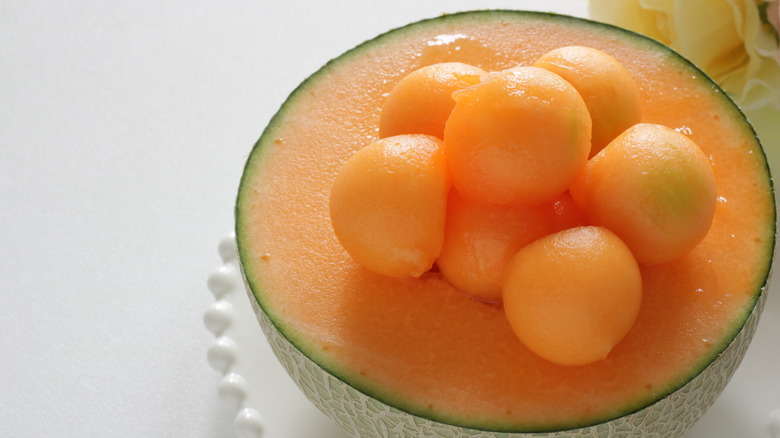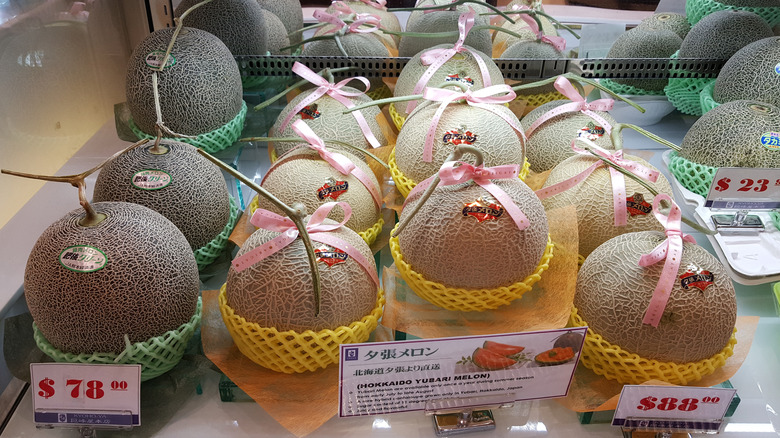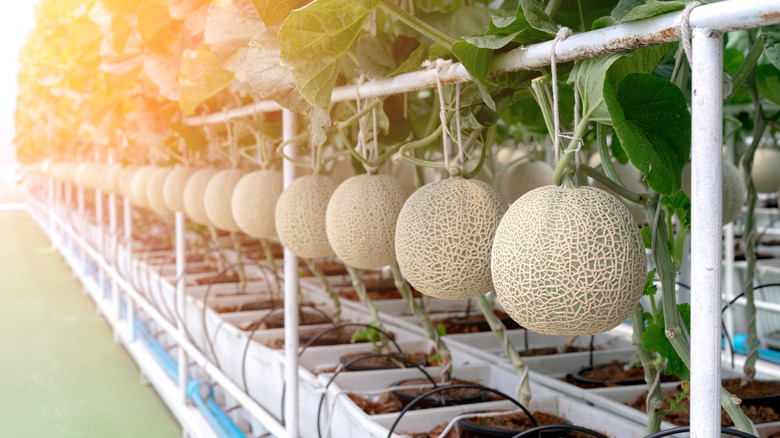This May Be The Most Expensive Melon In The World
Inflation may be dictating what we can and can't buy at the grocery store these days, but even with the skyrocketing price of food, we'd still struggle to find fruits that cost at about $200 apiece at an American supermarket — yet that's what you'd need to pay if you want to get your hands on a good Japanese Yubari King melon, per Insider. Taste Atlas says these melons stand out because they are perfect in every way — in shape, texture, and sweetness.
Yubari King melons are grown in central Japan's Shizuoka prefecture with each melon given 100 days to grow from seed to fruit. The farmers that grow these melons have the methodology down to a science and the fruits are all lovingly raised in a controlled environment that includes raised beds and specific amounts of water, with both heating and air conditioning to keep temperatures even. After fruits appear, they are wrapped in white paper. And when they begin to show their webbed appearance, farmers then don white gloves to hand polish and massage these pampered beauties (via Insider).
Yubari King melons are graded according to quality
Once Yubari King melons are harvested, they are graded; Those with flaws are given the lowest mark, or "yuki," while the remaining top three tiers — "fuji," "yama," and "shiro" — are decided based on levels of sweetness and perfection, with only 1 out of every 1,000 melons harvested making the highest grade, or "fuji" cut. Small wonder then that the Yubari King melons have set records by going for $45,000 a pair, during an auction in 2019, per Insider.
Before you ask whether this is a bit excessive, understand that agriculture is considered a particularly challenging industry in Japan, where just 12.13% of land area would be used in cultivation in 2018, per Trading Economics. That's much less than the 44.36 % that was available to the United States that same year, per Trading Economics, and the 71.21% in the United Kingdom in 2018, per Trading Economics. As a result, Japan devotes most of this land to essentials — producing 98% percent of the rice it consumes, 76% of vegetables, and just 30% of fruits, per The Diplomat.
Fruits play a different role in Japanese society
Because of this, fruits fill a different cultural role. The University of Wisconsin-Madison's Soyeon Shim, who is dean of the School of Human Ecology, tells CNN that "fruit purchase and consumption are tied to social and cultural practices. It is not only an important part of their diet, but, perhaps more importantly, fruit is considered a luxury item and plays an important and elaborate ritual part in Japan's extensive gift-giving practices."
Fruit distributor Hiroko Ishikawa agrees. He explained to the BBC that "when it comes to fruit it is still a luxurious item, not like vegetables. Vegetables you need for daily life but you can live without eating fruit. So if you are to buy something you might as well buy something that looks good. You don't want scarred or deformed because you are paying for the fruit. It just looks better."
As a result, it's not unsurprising to see $10 white strawberries, $94 square Zentsuji Watermelons, $250 Densuke watermelons, as much as $4,000 for a bunch of Ruby Roman grapes, and $4,000 for a Bijin-hime strawberry, per Tokyo Treat. When compared to these, the Yubari King melon could be considered a bargain.


